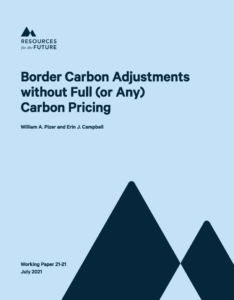Full Title: Border Carbon Adjustments without Full (or Any) Carbon Pricing
Author(s): William Pizer, Erin Campbell
Publisher(s): Resources for the Future
Publication Date: July 29, 2021
Full Text: Download Resource
Description (excerpt):
Border carbon adjustments (BCAs) are national or possibly multicountry trade measures—typically taxes on imports (and sometimes rebates on exports)—intended to support ambitious national climate mitigation policies. They are meant to address part of the problem that ambitious mitigation policies in one jurisdiction can lead to increased emissions in jurisdictions with less ambitious policies (“leakage”). In particular, they address the portion of leakage associated with energy-intensive production moving from areas with more ambitious policies to those with weaker policies (“competitiveness”). BCAs are being discussed as part of broader carbon pricing policies, like the European Union’s Emissions Trading Scheme (EU ETS), which recently put forward a concrete BCA proposal; they have also been described and modeled alongside a domestic carbon tax. Much has been written about the design of a BCA in this world with what we might call “full” carbon pricing.
Yet, nations’ climate mitigation policies may or may not include carbon pricing, and when they do, the carbon pricing is often not comprehensive. In the United States, for example, carbon pricing has been implemented at the state level (California, Washington State, and the northeastern states’ Regional Greenhouse Gas Initiative) but is currently a lower priority in national policy than incentives and regulatory standards. China has implemented an ETS that allocates free allowances based on performance benchmarks like a firm’s production level of electricity or (in the future) other industrial products. That is, the policy might regulate tons of CO2 per megawatt of electricity, per ton of steel produced, or per ton of cement. This is frequently referred to as a tradable performance standard (TPS; see Pizer and Zhang 2018). Even the EU ETS gives significant free allocation to energy-intensive, trade-exposed industries, thereby blunting some of the ETS effects. This raises the question of how a BCA might work with a “partial-price” or “nonprice” policy.
In this paper, we talk about “partial” price policy as implementing an explicit carbon price that is paid on some, but not all of a firm’s actual emissions. Perhaps there is a free allocation tied, one way or another, to production of a given product. This might be explicit, through a tradable performance standard or output-based allocation, or implicit, through a free allocation that helps address competitiveness effects.
